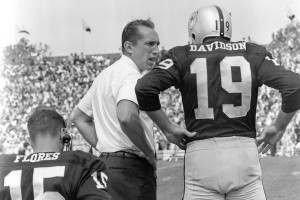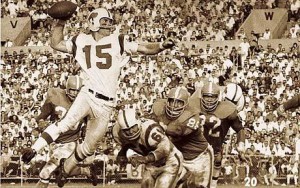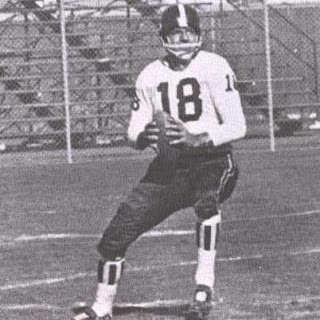As I have already stated in earlier NFL 100 posts, the story of the league’s 100 year history is not complete without mention of the contributions of the American Football League, which began play in 1960 and merged with the NFL later that decade to form what is today’s vastly popular sport. The AFL teams that began play in ’60 are all celebrating their 60th year of existence this season. I’m writing this post to remember the quarterbacks who helped the fledgling league get off the ground and grow into an entity that would attract fans and survive against the stiff competition from the established NFL. The quarterbacks who I speak of all have one thing in common. They had opportunities to play in the NFL but couldn’t crack the rosters of any of the teams in the older league, which had only 12 teams at the time. Remembering that Bart Starr was a 17th round draft choice and John Unitas was cut by Pittsburgh before finding success, the NFL management teams, who were certainly a lot less sophisticated than today’s, were capable of making mistakes. So the AFL gave some of the signal callers who came up short of success in the NFL what they needed – opportunity. Of course, sportswriters who followed the NFL, with encouragement from NFL executives, ridiculed all the AFL guys as “NFL rejects”. Some of them turned out to be a lot more than that, and all of them gave the fans of their hometown clubs reason to cheer. Here are some of their stories:
George Blanda, the original QB of the Houston Oilers who led that team to the first 2 AFL championships, could hardly be called an “NFL reject”. He spent 10 years in the older league, mostly with the Chicago Bears. He was a backup quarterback most of those years but it was an injury, not poor play, that relegated him to that duty. He had been retired for a year when the AFL came calling and he grabbed the opportunity, quickly setting AFL passing records and becoming one of the league’s first star players. His career, which began in 1949, lasted until 1975 and although by then he was mostly just a placekicker, he still earned his way in the Pro Football Hall of Fame.
Lamar Hunt’s Dallas Texans, who would eventually become the Kansas City Chiefs, also turned to a guy who couldn’t cut it in the NFL, Cotton Davidson. He had a cup of coffee with the Baltimore Colts in the mid-1950s but had been out of football for 2 years when he joined the club. He only lasted 2 years in Dallas because the team’s coach, Hank Stram, decided to bring in a player he had a close relationship with while he was an assistant coach at Purdue, Len Dawson. Dawson and Stram went on to have great success. They won the AFL title in their first season together in 1962 and after moving to Kansas City upset the Minnesota Vikings in Super Bowl IV. Davidson didn’t fade away, however. He moved on to Oakland where he guided the Raiders through some tough early years into a successful transition to winning under Al Davis, from 1962 until 1968, sharing QB duties with a future Raider coach, Tom Flores.

Al Davis, Cotton Davidson talk strategy with Tom Flores nearby
Sid Gillman, picked to coach the Los Angeles Chargers, came to the new league with the reputation of having built an offensive powerhouse with the Los Angeles Rams of the NFL in the ’50s. He did the same with the Chargers, at first using another recycled NFL signal caller in Jack Kemp. Kemp guided the team, in L.A. and in 1961 in San Diego, to title game appearances. The team went to rookie John Hadl in 1962 and faltered to a losing season. Early in ’62 they tried to sneak Kemp through waivers and the Buffalo Bills claimed him for the $100 waiver price. Another ex-NFLer, Tobin Rote, was brought in and he led the Chargers to a win in the title game in ’63. Rote and Hadl split the QB duties the next year but Hadl eventually won the job and developed into one of the AFL’s top stars. Meanwhile in Buffalo, Bills’ coach Lou Saban was thrilled to get the veteran Kemp to lead his team, and lead he did, combining a top offensive attack with the AFL’s best defense to win back-to-back championships in the mid-1960s. Buffalo had struggled to stabilize the QB position in their early years. Their first draft pick ever, college star Richie Lucas, was supposed to be the cornerstone of the new team but turned out to be a bust. The team cycled through no-names like Johnny Green, Tommy O’Connell, Warren Rabb, M.C. Reynolds and Al Dorow before Kemp came on board and steadied the ship.

Jack Kemp fires a “jump pass” against the Oilers
The New York Titans, like Buffalo, struggled to find a quarterback at first. Their initial starter was Dorow, but they swapped him out with the Bills for Johnny Green, and over time, tried the likes of Dick Jameison, Butch Songin, Lee Grosscup, Dick Wood, Galen Hall and Pete Liske before landing the guy who would save the franchise, and possibly the entire league, Joe Namath, in 1965. In Boston, the Patriots began their inaugural season with Songin under center. Seeing a pattern here? Yes, the early AFL teams pretty much played musical QBs with guys like Dorow, Green and Songin trying to find a combination that worked. The Pats found their man early in 1961 when Vito “Babe” Parilli took the reins of their offense. He led the team through most of the AFL’s existence and made them a solid Eastern Division contender almost every year. The final team of the 8 AFL original franchises for us to cover was the Denver Broncos. They were the losingest club of all among the AFL’s teams in the 10 year existence of the league and were so cheap they wore old high school uniforms with ugly vertical striped socks in their first year, but that didn’t mean they had no exciting quarterbacks. For a lousy team, they had some of the AFL’s most thrilling players, like Gene Mingo, Lionel Taylor and their QB, Frank Tripucka. Tripucka kept the faltering Denver team afloat in their first 4 seasons, guiding a wild and wooly offensive attack. A reject of both the NFL and the Canadian Football League, he played well enough in those early years that his jersey number 18 is retired by the franchise. When the Broncos signed Peyton Manning in 2012, Tripucka granted the Broncos permission to “unretire” the number so Manning could wear it. Tripucka eventually gave way to the likes of Mickey Slaughter, Jacky Lee and John McCormick as Bronco QBs, while the team compiled the worst record of all in the AFL’s existence. Almost all of these gladiator signal callers are mere footnotes in pro football’s 100 year history, but they all carved out their small slice of that history, collectively lifting up the sport until it grew into the television spectacle it is today.

Denver’s Frank Tripucka, sporting his vertical striped socks